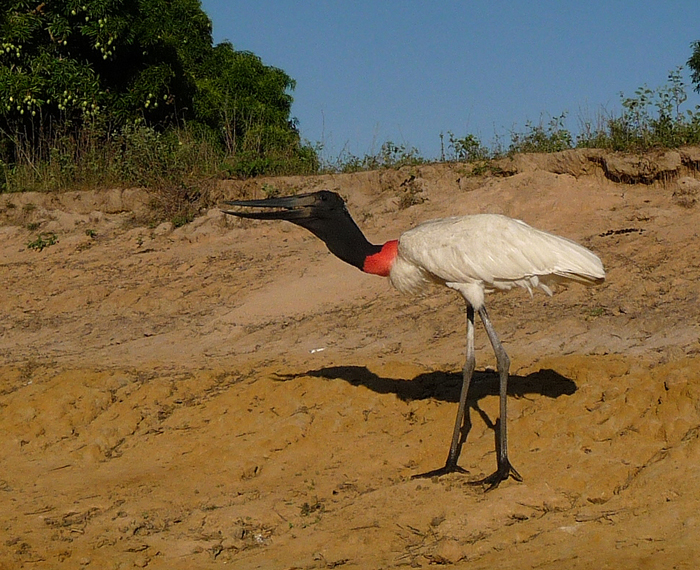Home | Tours | Trip Reports | News | Team | Calendar | Links | Contact | Store | Mailing List
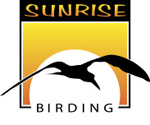 PANTANAL
PANTANALPhotos & Trip Report
October 14 - 23, 2009
Leaders:
Gina Nichol, Steve Bird, & Miguel
Castelino
TRIP REPORT> PHOTO HIGHLIGHTS>
SPECIES LIST(pdf)>
Trip Report
By Gina Nichol & Steve Bird. For photo credits, mouse over each photo.
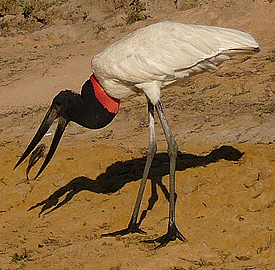
Jabiru. Photo by Gina Nichol
Day 1 - Wednesday, October 14
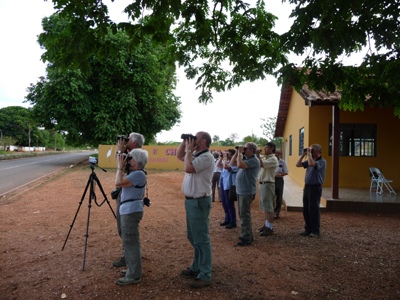 Some of us were on the tour at Serra dos Tucanos and flew to Cuiaba in the morning to begin the Pantanal tour. Others flew overnight from London arriving in Cuiaba a few minutes later (perfect!). We met our guide Miguel and Manuel our driver and were soon on the way toward the famous Pantanal. We drove to Poconé and stopped for lunch just before the beginning of the Transpantaneira Highway a 149km of dirt track crossing over no less than 126 wooden bridges and ending at the Cuiaba River. Our lunch stop was our first introduction to a traditional Brazilian Churasscaria where a buffet meal is accompanied by giant skewers of steak, pork, chicken, sausages and other things unrecognizable! all served up by wandering “gauchos”. Nobody could ever go hungry after such a meaty feast. Our journey to this gastronomic delight introduced us to our first Black Vultures, Plumbeous Kite, Fork-tailed Flycatcher, Little Blue Herons and some huge Jabirus perched in a tree. A quick stop at a wetland area also produced Buff-necked Ibis, Bare-faced Ibis, White-winged Swallows, Picazuro Pigeons and Southern Lapwings.
Some of us were on the tour at Serra dos Tucanos and flew to Cuiaba in the morning to begin the Pantanal tour. Others flew overnight from London arriving in Cuiaba a few minutes later (perfect!). We met our guide Miguel and Manuel our driver and were soon on the way toward the famous Pantanal. We drove to Poconé and stopped for lunch just before the beginning of the Transpantaneira Highway a 149km of dirt track crossing over no less than 126 wooden bridges and ending at the Cuiaba River. Our lunch stop was our first introduction to a traditional Brazilian Churasscaria where a buffet meal is accompanied by giant skewers of steak, pork, chicken, sausages and other things unrecognizable! all served up by wandering “gauchos”. Nobody could ever go hungry after such a meaty feast. Our journey to this gastronomic delight introduced us to our first Black Vultures, Plumbeous Kite, Fork-tailed Flycatcher, Little Blue Herons and some huge Jabirus perched in a tree. A quick stop at a wetland area also produced Buff-necked Ibis, Bare-faced Ibis, White-winged Swallows, Picazuro Pigeons and Southern Lapwings.
Around the car park of the restaurant we were distracted by a male Green-barred Woodpecker which showed very well in the tree above the bus while several Yellow-chevroned Parakeets were seen flying around, eventually perching for equally good views. A Streaked Flycatcher was perched on a fence across the road and a Pale-vented Pigeon was scoped on a distant dead three. We then had a Rufous-bellied Thrush that appeared by the fence and there were several Rufous Horneros around. A pair of Toco Toucans was seen in some trees up the road and our first punky haired Guira Cuckoos were ticked. A Chalk-browed Mockingbird appeared on another fence as well as some Saffron Finches and House Sparrows.
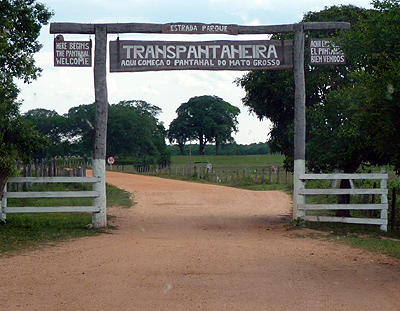 After lunch, we headed to the Transpantaneira Highway. Our first hotel was just 64 km away and we had the rest of the afternoon to drive leisurely along the road and bird. It soon became apparent that the birding was going to be excellent. The first small pond on the left side held Bare-faced Ibis, Brazilian Teal, Snail Kite and Green Ibis and there were two Plumbeous Kites flying above. The power lines along the road held Brown-chested Martin and a Chalk-browed Mockingbird was seen, before we stopped for a lovely Capped Heron. At the same spot we ticked both male and female Unicolored Blackbird (similar to Chopi Blackbirds but lives in different habitats). A female Rusty-collared Seedeater was seen and we picked up our first Chaco Chachalacas sat under a tree. A Toco Toucan flew across and every bit of water seemed to have either a Wattled Jacana or a Black-capped Donacobius or both. Rufescent Tiger-herons were seen and our first male Scarlet-headed Blackbird was a stunner.
After lunch, we headed to the Transpantaneira Highway. Our first hotel was just 64 km away and we had the rest of the afternoon to drive leisurely along the road and bird. It soon became apparent that the birding was going to be excellent. The first small pond on the left side held Bare-faced Ibis, Brazilian Teal, Snail Kite and Green Ibis and there were two Plumbeous Kites flying above. The power lines along the road held Brown-chested Martin and a Chalk-browed Mockingbird was seen, before we stopped for a lovely Capped Heron. At the same spot we ticked both male and female Unicolored Blackbird (similar to Chopi Blackbirds but lives in different habitats). A female Rusty-collared Seedeater was seen and we picked up our first Chaco Chachalacas sat under a tree. A Toco Toucan flew across and every bit of water seemed to have either a Wattled Jacana or a Black-capped Donacobius or both. Rufescent Tiger-herons were seen and our first male Scarlet-headed Blackbird was a stunner.
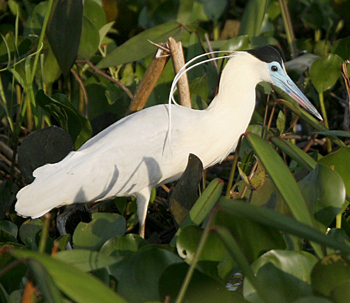 We continued along the “highway” adding a host of birds including Ruddy Ground Dove, Yellow-billed Cardinal, Ringed Kingfisher, Capped Heron, Striated Heron, Green Kingfisher, Limpkin, Wood Stork, Snowy and Great Egrets, and Cocoi Heron. A couple of young Jabirus were seen close to the road and Miguel said that they had probably left the nest just a few weeks ago. Our next stop was for some Greater Rheas walking in a cow field. While we were watching the Rheas, Leslie spotted at Purplish Jay that flew into a nearby tree and further on, we had two Red-legged Seriemas in another cow field, calling and allowing good views. Another stop at a small pond yielded Solitary Sandpiper and some Gray-breasted Wood Rails that ran off quickly. A Cattle Tyrant was seen near the pond and Green Ibis was added to our rapidly growing list. We drove through the landscape which included sprawling cow fields and wet areas near the road. The cow fields were dotted with large conical Termite nests and one mound had the nest of Campo Flickers in it. Many of us missed a Black-tailed Tityra in the canopy of a large tree but we got very satisfying looks at Guira Cuckoo.
We continued along the “highway” adding a host of birds including Ruddy Ground Dove, Yellow-billed Cardinal, Ringed Kingfisher, Capped Heron, Striated Heron, Green Kingfisher, Limpkin, Wood Stork, Snowy and Great Egrets, and Cocoi Heron. A couple of young Jabirus were seen close to the road and Miguel said that they had probably left the nest just a few weeks ago. Our next stop was for some Greater Rheas walking in a cow field. While we were watching the Rheas, Leslie spotted at Purplish Jay that flew into a nearby tree and further on, we had two Red-legged Seriemas in another cow field, calling and allowing good views. Another stop at a small pond yielded Solitary Sandpiper and some Gray-breasted Wood Rails that ran off quickly. A Cattle Tyrant was seen near the pond and Green Ibis was added to our rapidly growing list. We drove through the landscape which included sprawling cow fields and wet areas near the road. The cow fields were dotted with large conical Termite nests and one mound had the nest of Campo Flickers in it. Many of us missed a Black-tailed Tityra in the canopy of a large tree but we got very satisfying looks at Guira Cuckoo.
We drove through the official gate to the Pantanal and passed more wetlands and field that held lots of cows and their attendant Cattle Egrets. Our first Black-backed Stilts were counted and Southern Screamers were evident in the distance. At a stop near a ranch entrance, we had several Monk Parakeets dwarfed by our first stunning Hyacinth Macaw that flew through and landed in a palm tree. This brilliant blue bird elicited gasps from the crowd as it sat on a palm frond. Not long after, another Hyacinth Macaw flew across the field straight at, and over us once again earning 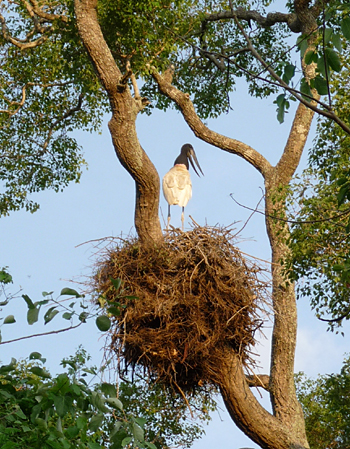 appreciative praise. Other birds in the wetter areas included White-headed Marsh Tyrant and Black-bellied Whistling Duck. A pair of Southern Caracaras was observed mating in a tree and there were several Yellow-rumped Caciques around. Doreen then spotted a Narrow-billed Woodcreeper working up the trunk of a Strangler Fig right in front of us allowing good views.
appreciative praise. Other birds in the wetter areas included White-headed Marsh Tyrant and Black-bellied Whistling Duck. A pair of Southern Caracaras was observed mating in a tree and there were several Yellow-rumped Caciques around. Doreen then spotted a Narrow-billed Woodcreeper working up the trunk of a Strangler Fig right in front of us allowing good views.
Back on the bus, we stopped to see a pair of Bare-faced Curassows walking on the ground not far from the road. We then crossed our first of 126 bridges and stopped briefly for Gray-breasted Wood Rail, Anhinga, Limpkin, Black-collared Hawk, Black-crowned Night Heron, Roseate Spoonbill, and a very nice looking Maguari Stork. It was fabulous birding, there were birds everywhere! Next up were some Muscovy Ducks and a pair of Yellow-rumped Caciques building a nest, then we had a Wing-barred Water Tyrant (split from Pied Water Tyrant) which was perched on some reeds near another wet area and an Amazon Kingfisher sat up on a branch overlooking some open water. Our first Capybaras were seen along a pond edge and our next stop was for a Jabiru on a nest which seemed to also play home to a pair of Monk Parakeets. While we watched and photographed this bird, an Orange-backed Oriole flew in and perched on top of a Cecropia tree in perfect light.
 The sun was beginning to set and now there were several groups of Capybaras including some young ones near the roadside pools. A Yellow-headed Caracara flew across an open area and perched and ahead of us while some South American Coatis crossed the road. Our next stop along the road yielded Blue-fronted Parrots, Great Black-Hawk, White-tipped Dove, Shiny Cowbird, Gray-crested Cachalote and Thrush-like Wren. A pair of endemic Chestnut-bellied Guans showed well for us in the late afternoon sun and next up was the largest deer in South America, a large male Marsh Deer with velvet covered horns.
The sun was beginning to set and now there were several groups of Capybaras including some young ones near the roadside pools. A Yellow-headed Caracara flew across an open area and perched and ahead of us while some South American Coatis crossed the road. Our next stop along the road yielded Blue-fronted Parrots, Great Black-Hawk, White-tipped Dove, Shiny Cowbird, Gray-crested Cachalote and Thrush-like Wren. A pair of endemic Chestnut-bellied Guans showed well for us in the late afternoon sun and next up was the largest deer in South America, a large male Marsh Deer with velvet covered horns.
By now it was dark and Steve and Miguel were spotlighting from the bus. A Spot-tailed Nightjar flew off quickly but we got great views of a Boat-billed Heron perched on an open branch. As we traveled through the dark, we got varying views of Pantanal Caiman, Crab-eating Raccoon, a couple of Crab-eating Foxes, and more Marsh Deer. The highlight for many was prolonged looks at an Ocelot walking slowly through the grass and then sitting for several minutes seemingly unfazed by the light. Fantastic! We arrived at our hotel after a wonderful first day and kudos must go to the four people that had been traveling for many hours from the UK. We were all tired but managed dinner and a review of the day’s checklist before retiring for the evening.
Day 2 – Thursday, October 15
The sun was rising as we met in the restaurant for some early morning coffee and biscuits. It was a stunning day with clear blue skies and topped off by a visit from a Glittering-throated Emerald as we left the restaurant to board our boats for our cruise down the Pixiam River. Across the river was a Cocoi Heron and as we set off some Black-crowned Night-herons were seen perched in the morning sun. We enjoyed good views of many birds as we cruised quietly downstream including several Anhinga, Wood Stork, Snail Kite, Ringed Kingfisher and Little Blue Heron. A Great Black Hawk was perched in a tree and there were many Chaco Chachalacas, their harsh duetting songs serenading us as we progressed.
Our first Greater Anis were seen perched amongst the riverside vegetation showing their pale eyes and the purple iridescence on their feathers and we studied the differences between this species found in riverine habitats versus the smaller Smooth-billed Anis seen in dryer areas. A Sunbittern was spotted just ahead standing in the sun on the bank and as we got closer, it flew upriver past us giving us extraordinary views of its spectacular wing pattern.
Next up was a nice Rusty-margined Flycatcher and an American Pygmy Kingfisher was seen fishing from a low perch. Piratic Flycatchers was around and a Large-billed Tern flew down the river ahead of us. There were a couple of Black-fronted Nunbirds perched in a Cecropia and our first of many Blue-throated Piping Guans. Miguel heard the calls of Red-billed Scythebills on both sides of the river and just then one flew across and landed on a bare trunk showing well. Some Rusty-backed Spinetails were working in the grasses on the side of the river and then two Hyacinth Macaws crossed over the river in front of us. Wow!
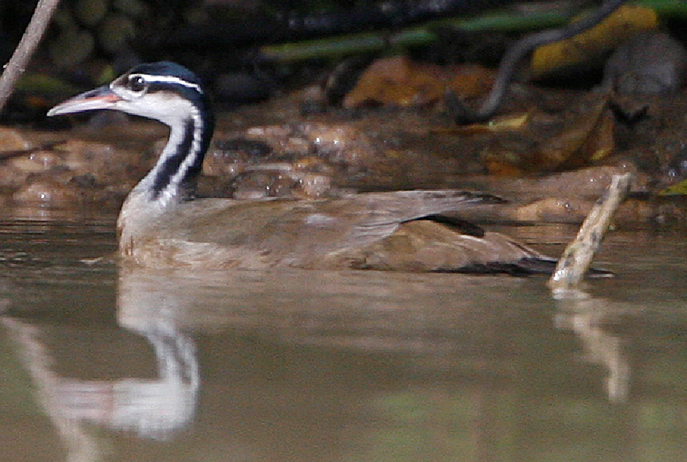 There were several Pantanal Caiman in the water and on the banks reminding us that this wasn’t the best place for a swim! Miguel found a Green-and-Rufous Kingfisher tucked in under some roots on the bank and some of us managed very difficult views. A Green Kingfisher was much easier as were several Gray-necked Wood Rails walking along the river edges. A Sungrebe was seen just before it went into hiding under some thick cover on the bank as a pair of Silver-beaked Tanagers tried to distract us as they sat in the branches above. We passed by an open area covered with water hyacinth and saw several Black-capped Donacobius working among the large leaves. A Rufous-tailed Jacamar was seen perched overlooking the river and as we were admiring that a Little Cuckoo flew across the river and perched briefly in the open. Next up was a Roadside Hawk that flew over distracting us briefly and then a perched Black-collared Hawk took flight across the river picking up something as it went by. A Boat-billed Flycatcher was seen as were some Lesser Kiskadees at an area where the river became totally closed in by Water Hyacinth. We turned back upstream and Miguel pointed out a Flavescent Warbler bathing but it quickly disappeared. Nearby a Solitary Cacique was building a nest and another American Pygmy Kingfisher was perched out in the open. A Blue-crowned Trogon flew across the river and landed on a bare branch in the open allowing excellent views, while further on there was a sandy island in the middle of the river which held a Large-billed Tern and a Solitary Sandpiper. We returned to the boat dock after a morning that could only be described as magical and enjoyed breakfast while reminiscing about all we had seen before 8 AM.
There were several Pantanal Caiman in the water and on the banks reminding us that this wasn’t the best place for a swim! Miguel found a Green-and-Rufous Kingfisher tucked in under some roots on the bank and some of us managed very difficult views. A Green Kingfisher was much easier as were several Gray-necked Wood Rails walking along the river edges. A Sungrebe was seen just before it went into hiding under some thick cover on the bank as a pair of Silver-beaked Tanagers tried to distract us as they sat in the branches above. We passed by an open area covered with water hyacinth and saw several Black-capped Donacobius working among the large leaves. A Rufous-tailed Jacamar was seen perched overlooking the river and as we were admiring that a Little Cuckoo flew across the river and perched briefly in the open. Next up was a Roadside Hawk that flew over distracting us briefly and then a perched Black-collared Hawk took flight across the river picking up something as it went by. A Boat-billed Flycatcher was seen as were some Lesser Kiskadees at an area where the river became totally closed in by Water Hyacinth. We turned back upstream and Miguel pointed out a Flavescent Warbler bathing but it quickly disappeared. Nearby a Solitary Cacique was building a nest and another American Pygmy Kingfisher was perched out in the open. A Blue-crowned Trogon flew across the river and landed on a bare branch in the open allowing excellent views, while further on there was a sandy island in the middle of the river which held a Large-billed Tern and a Solitary Sandpiper. We returned to the boat dock after a morning that could only be described as magical and enjoyed breakfast while reminiscing about all we had seen before 8 AM.
The birding really never stopped as some Purplish Jays were ticked from the breakfast table. And at the lodge feeders, there were Scaled Doves, Shiny Cowbirds, Yellow-billed Cardinals, Saffron Finches and a few Bay-winged Cowbirds. As we walked back out to the river to meet up for our morning walk, a Fork-tailed Flycatcher was spotted perched in a tree above the bank. As we gathered, we could feel the heat of the day beginning to build up and we set off for a walk in the dry forest adjacent to the river. A Green Iguana was walking on the river bank and further out our first Pale-legged Hornero was seen. At the beginning of the trail a young Great Horned Owl was perched on a large branch making begging calls and all the time keeping his huge eyes fixed on us. A Greater Thornbird flew into a nearby tree trunk and showed well and Miguel pointed out its ball shaped nest in a distant tree. Next was a Rufous-fronted Thornbird (split from Common Thornbird) working near its elongated stick nest. An Amazon RaceRunner Lizard was seen and close views allowed us to get to grips with the common Brown-chested Martin.
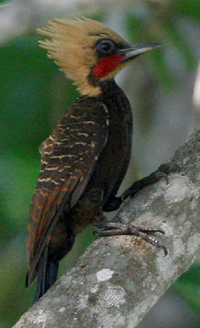 In the forest we got very fleeting glimpses of White-lored Spinetail which were much improved later. A pair of Mato Grosso Antbirds was much more confiding showing well for all of us as did Rusty-backed Spinetail. A Sungrebe was seen working along the edge of the river and some of us got close, albeit quick views. Around the next corner, a pair of Large-billed Antwrens were seen and as we were watching them, Steve put his scope on our first Pale-crested Woodpecker working on a low trunk. A Rusty-fronted Tody Flycatcher circled around us eventually showing well and a pair of Band-tailed Antbirds was put on a good performance. A female Cream-colored Woodpecker was spotted up under the canopy and a Swainson’s Flycatcher was found. We left the forest and walked out into an open scrub area where we found Squirrel Cuckoo, Short-crested Flycatcher, Pearly-vented Tody Tyrant and heard a Bananaquit. As we walked through the heat back to the lodge, a Rusty-collared Seedeater was seen near a pond.
In the forest we got very fleeting glimpses of White-lored Spinetail which were much improved later. A pair of Mato Grosso Antbirds was much more confiding showing well for all of us as did Rusty-backed Spinetail. A Sungrebe was seen working along the edge of the river and some of us got close, albeit quick views. Around the next corner, a pair of Large-billed Antwrens were seen and as we were watching them, Steve put his scope on our first Pale-crested Woodpecker working on a low trunk. A Rusty-fronted Tody Flycatcher circled around us eventually showing well and a pair of Band-tailed Antbirds was put on a good performance. A female Cream-colored Woodpecker was spotted up under the canopy and a Swainson’s Flycatcher was found. We left the forest and walked out into an open scrub area where we found Squirrel Cuckoo, Short-crested Flycatcher, Pearly-vented Tody Tyrant and heard a Bananaquit. As we walked through the heat back to the lodge, a Rusty-collared Seedeater was seen near a pond.
After lunch, we loaded the bus and continued down the Transpantaneira highway. Our destination was the end of the highway and our lodge on the Cuiaba River and we had all afternoon to get there. We crossed over many bridges and enjoyed views of Capybaras bathing, Pantanal Caimans lurking, Southern Rough-winged Swallows flying around and Black-collared Hawks and Snail Kites perched out in the open around the wet areas. Marsh Deer were seen and we added Blue-black Grassquit to our trip list.
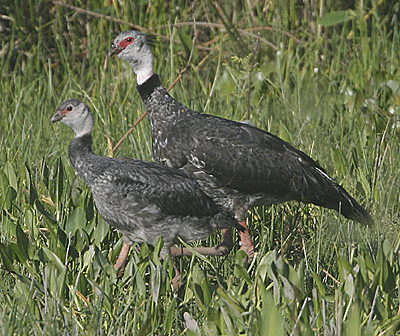 From one of the bridges there was a small pond which held Roseate Spoonbill, Limpkin and Wood Stork. Further on, a Lesser Yellow-headed Vulture was seen on the ground and there were several Southern Screamer families with chicks of varying ages. Steve spotted a large dark furry animal not far from the road and it turned out to be a Giant Anteater seemingly out of place in some tall grasses. There turned out to be two Giant Anteaters and both disappeared – one into the grasses and the other behind a bush.
From one of the bridges there was a small pond which held Roseate Spoonbill, Limpkin and Wood Stork. Further on, a Lesser Yellow-headed Vulture was seen on the ground and there were several Southern Screamer families with chicks of varying ages. Steve spotted a large dark furry animal not far from the road and it turned out to be a Giant Anteater seemingly out of place in some tall grasses. There turned out to be two Giant Anteaters and both disappeared – one into the grasses and the other behind a bush.
We waited a while for the one behind the bush to appear but it never showed. A stunning Scarlet-headed Blackbird had to suffice but we made note of the area to check on our return journey in a few days. Next, we made a comfort/birding stop at a small lodge where there was a colony of Yellow-rumped Caciques in the garden. Steve spotted a Vermillion Flycatcher on a low branch and we studied Gray-breasted Martins on the wires and ticked our first Chopi Blackbirds.
Continuing on we added Picui Ground Dove and a nice Maguari Stork looking good in the afternoon light. A juvenile Rufescent Tiger-Heron was seen and across the road was a large flock of Unicolored Blackbirds. A Ferruginous Pygmy-Owl was spotted in a tree next to a bridge but as we reversed to see it, the bird flew off. There were many Southern Caracaras in and around the road as we traveled
After the sun set, we stopped at a bridge overlooking a marshy areas on either side. We could hear Gray-breasted Crake and searched with spotlights but could not pick it up. A Band-tailed Nighthawk was also heard but our attention was distracted by a Margay that crossed the road and quickly disappeared. Back on the bridge, a Pauraque was seen. We arrived at our lovely lodge and checked into our rooms before dinner.
Day 3 - Friday, October 16
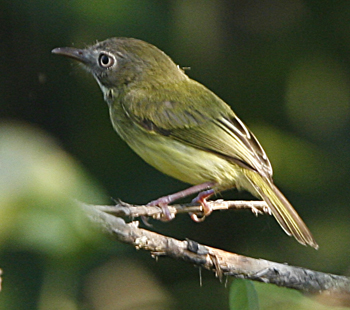 This morning we were up early at the lovely Porto Jofre hotel and after breakfast we set off for our morning birding excursion. On the way out of the hotel, we stopped for good views of Picui Ground Doves mixed in with some Ruddy Ground Doves on the ground just outside the gate. We then crossed the small airplane runway and got out to the main road where we spotted our first Chestnut-eared Aracari from the bus. After parking not far away, we found there were three more of these smart birds in the nearby trees. As they flew off, a Blue-crowned Trogon flew in and landed nearby while a Little Woodpecker was seen working its way up a branch on a closer Cecropia. Throughout the morning we saw and heard many Blue-throated Piping Guans, some allowing great close up views. In a low tangle, there was a nice Fawn-breasted Wren and then a Stripe-necked Tody-Tyrant was spotted. We heard an Undulated Tinamou in the forest and Miguel managed to coax it out and it walked across the track right in front of us. Fantastic! Still not 20 meters from the bus, we started walking down a dirt track. There were many Yellow-chevroned Parakeets flying around and noisily feeding in the trees. Several Yellow-rumped Caciques flew back and forth over the trail and Miguel got us on to a couple of Crested Oropendolas moving around some tall trees off the trail. A young Brown Capuchin Monkey was climbing in a tree above us and we found a Dull-capped (White-eyed) Attila close by in some bushes. Over the course of the morning several Toco Toucans were seen in the tree tops, while a large bare tree held several birds including Purplish Jay, Black Vulture, Southern Caracara and a perched Red-throated Piping Guan which allowed scope views for a short time. Further down the trail, a Rufous-tailed Jacamar glowed as it sat in the sun on a horizontal branch, allowing some of the group to get really nice video. It was nearly 8.00am and the heat of the day was kicking in so we walked from shady spot to shady spot ticking birds as we went along. A Black-tailed Tityra was seen under the canopy of a large tree, and as we were watching it an Orange-backed Oriole flew by. Gina and David spotted a bright yellow bird which turned out to be a Thick-billed Euphonia which got away before anyone else could get on it, meanwhile, the rest of the group were watching some Double-collared Seedeaters feeding on some tall grasses. A Blue-tufted Starthroat was scoped as it perched in a wispy tree and further down the path a Brazilian Cavy was seen on the grassy verge.
This morning we were up early at the lovely Porto Jofre hotel and after breakfast we set off for our morning birding excursion. On the way out of the hotel, we stopped for good views of Picui Ground Doves mixed in with some Ruddy Ground Doves on the ground just outside the gate. We then crossed the small airplane runway and got out to the main road where we spotted our first Chestnut-eared Aracari from the bus. After parking not far away, we found there were three more of these smart birds in the nearby trees. As they flew off, a Blue-crowned Trogon flew in and landed nearby while a Little Woodpecker was seen working its way up a branch on a closer Cecropia. Throughout the morning we saw and heard many Blue-throated Piping Guans, some allowing great close up views. In a low tangle, there was a nice Fawn-breasted Wren and then a Stripe-necked Tody-Tyrant was spotted. We heard an Undulated Tinamou in the forest and Miguel managed to coax it out and it walked across the track right in front of us. Fantastic! Still not 20 meters from the bus, we started walking down a dirt track. There were many Yellow-chevroned Parakeets flying around and noisily feeding in the trees. Several Yellow-rumped Caciques flew back and forth over the trail and Miguel got us on to a couple of Crested Oropendolas moving around some tall trees off the trail. A young Brown Capuchin Monkey was climbing in a tree above us and we found a Dull-capped (White-eyed) Attila close by in some bushes. Over the course of the morning several Toco Toucans were seen in the tree tops, while a large bare tree held several birds including Purplish Jay, Black Vulture, Southern Caracara and a perched Red-throated Piping Guan which allowed scope views for a short time. Further down the trail, a Rufous-tailed Jacamar glowed as it sat in the sun on a horizontal branch, allowing some of the group to get really nice video. It was nearly 8.00am and the heat of the day was kicking in so we walked from shady spot to shady spot ticking birds as we went along. A Black-tailed Tityra was seen under the canopy of a large tree, and as we were watching it an Orange-backed Oriole flew by. Gina and David spotted a bright yellow bird which turned out to be a Thick-billed Euphonia which got away before anyone else could get on it, meanwhile, the rest of the group were watching some Double-collared Seedeaters feeding on some tall grasses. A Blue-tufted Starthroat was scoped as it perched in a wispy tree and further down the path a Brazilian Cavy was seen on the grassy verge.
At the next shady spot, we stopped to watch a Little Woodpecker working a close branch, and then Miguel began to whistle the call of Ferruginous Pygmy-owl and soon one was calling back from a large tree. A mob of other birds was forming in the tree and a Great Antshrike chased the owl to another branch. Silver-beaked Tanagers were agitated and noisy Rufous Horneros joined in the fray. Soon the owl flew out of the tree over the trail with a second owl in tow.
Next up was an amazingly confiding Short-crested Flycatcher within arm’s reach of us and posing for photos. A pair of Fawn-breasted Wrens showed at eye level in a dark bush and a Rusty-fronted Tody Flycatcher was also seen well. Miguel pointed out the Inga tree, a legume plant found in many areas of South America and a good food source for many birds. A pair of Barred Antshrikes appeared nearby and then we had a White-bellied Seedeater which flew over and then a Fuscous Flycatcher which flew back and forth over the path making it difficult to get a good view. The bird finally showed well for us a bit further up the trail. All the while, Lesser Yellow-headed Vultures were soaring overhead and we wondered if they were waiting for a casualty from the blazing heat. Miguel heard and then Steve spotted a Southern Beardless Tyrannulet in a low bush. The bird disappeared quickly but a nice Masked Gnatcatcher emerged from the bush as a bonus. After seeing the Gnatcatcher, the Southern Beardless Tyrannulet was scoped in a tiny tree just right of its original location. Just then a Bat Falcon flew over and circled several times allowing great flight views.
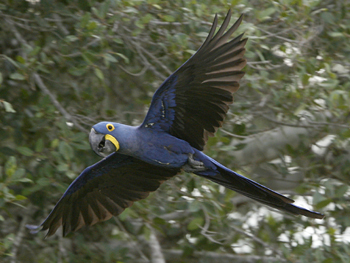 We ended up in the vicinity of an abandoned hotel by the river where a South American Coati was seen walking on the roof of one of the old buildings. Maurice spotted a Savannah Hawk perched on a small tree in the middle of the nearby cow field and while we were watching it, a Guira Cuckoo flew up from the ground and landed on a suspended wire. At the river, a Large-billed Tern flew past and a Chotoy Spinetail showed very well as it perched on a wire just 8ft off the ground. A few Yellow-billed Cardinals were flying back and forth and a Southern Caracara was perched in one of the big trees in front of the old hotel. We were all very happy to see Manuel with our air conditioned bus to take us back to the hotel. When we returned we spent a few minutes birding the grounds. Just above us in the car park were two stunning Hyacinth Macaws. Behind the rooms, there was a large pond covered with Giant Water Lilies and birds here included Jabiru, Rufescent Tiger Heron, and many Wattled Jacanas walking on the Giant Lily Pads. A few Dark-throated Seedeaters were watched feeding in the grasses and Peach-fronted Parakeets were seen.
We ended up in the vicinity of an abandoned hotel by the river where a South American Coati was seen walking on the roof of one of the old buildings. Maurice spotted a Savannah Hawk perched on a small tree in the middle of the nearby cow field and while we were watching it, a Guira Cuckoo flew up from the ground and landed on a suspended wire. At the river, a Large-billed Tern flew past and a Chotoy Spinetail showed very well as it perched on a wire just 8ft off the ground. A few Yellow-billed Cardinals were flying back and forth and a Southern Caracara was perched in one of the big trees in front of the old hotel. We were all very happy to see Manuel with our air conditioned bus to take us back to the hotel. When we returned we spent a few minutes birding the grounds. Just above us in the car park were two stunning Hyacinth Macaws. Behind the rooms, there was a large pond covered with Giant Water Lilies and birds here included Jabiru, Rufescent Tiger Heron, and many Wattled Jacanas walking on the Giant Lily Pads. A few Dark-throated Seedeaters were watched feeding in the grasses and Peach-fronted Parakeets were seen.
In the afternoon, we all elected to take an optional boat trip on the Cuiaba River to look for Jaguar. Our focus was to be this elusive cat but we still picked up some birds along the way including Sungrebe , Sunbittern , and Pied Lapwing, the latter being new for the trip. A highlight was five Giant Otters seen swimming along the shoreline for several minutes and we all had great views of them. Not much further on, Gina spotted a Tapir on the water’s edge. It had likely come down to the water to drink and most of us got on it before it retreated up the bank out of sight. On the way back down the river, Steve spotted another Tapir out in the open and again it retreated quickly allowing brief but good views. As the sun was setting it created marvelous pinkish hues on the water. Nighthawks began to appear above the river and these were soon identified as Band-tailed Nighthawks. The band on the tail became very evident when Miguel spotlighted the birds as they flew beside and over the boat. We scanned the shoreline with the spotlight and picked up a few Pauraques. Despite missing our target Jaguar it was a lovely evening and a very enjoyable cruise.
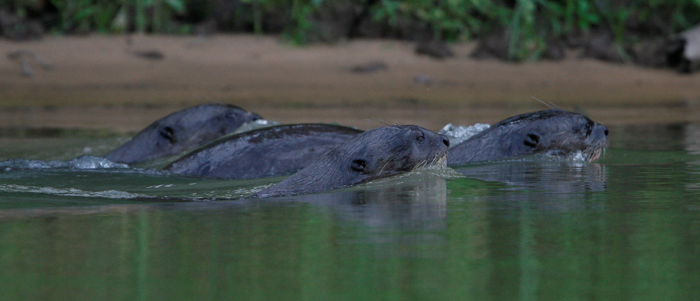
Day 4 - Saturday, October 17
After an early breakfast we were out on the main road birding before the heat of the day built up. A White-winged Becard flew back and forth over us eventually showing well. Once again there were noisy flocks of Yellow-chevroned Parakeets around and their chattering along with the sounds of duetting Chaco Chachalacas filled the air. Yellow-rumped Caciques were so common that we decided it was not necessary to mention them any more. Several Epaulet Orioles were seen on the tree tops and we were able to see the chestnut patch on the wings with the help of the scopes and there were also Black-fronted Nunbirds and a male Black-throated Mango that sat out on a bare branch allowing good views. A female Blue-black Grassquit was seen close to the road and a Squirrel Cuckoo made an appearance. A Boat-billed Flycatcher called from the canopy and a Barred Antshrike was seen, until our viewing was disrupted by a White Woodpecker that flew over and disappeared quickly.
We turned off the main road on to a path into the forest and as we left the road an Undulated Tinamou flew off from the verge and quickly disappeared. Ahead of us on a dead tree was a female Pale-crested Woodpecker and a female Green-breasted Mango showed well hovering around a flowering tree. A distant White-bellied Seedeater was scoped and better views were obtained later when another bird was seen much closer. A male Pale-crested Woodpecker flew by as most of us were watching some Thrush-like Wrens building a nest. We then came into an open area where two Plumbeous Ibis were perched on a dead tree, and then incredibly three Crimson-crested Woodpeckers flew in and worked up the open trunk of another dead tree. A Wood Stork flew in and displaced the Ibis but we were quickly distracted by a Masked Gnatcatcher working a large wispy tree behind us. A Rusty-fronted Tody Flycatcher was seen in a low tangle near to where we stood and we enjoyed excellent views of it and the Fuscous Flycatcher flitting around behind it. Further up the right side of a nearby tree, Steve found a Blue-crowned Trogon “left of the sun”.
Back out on the main road we had nice looks at Ashy-headed Greenlet and a very confiding pair of Pale-crested Woodpeckers that flew into the same tree and posed in the open. Beside us, a Southern Beardless Tyrannulet was building a nest in one of the ant trees and we had amazingly close views of this busy little bird. Just across the road, a Stripe-throated Tody-Tyrant was seen well.
The heat was building up as we walked to another side road leading toward the river. A Gray-headed Tanager was seen briefly and there were more Thrush-like Wrens building their tangled sticky nests. A Gray-crested Cachalote was seen well and some Chestnut-eared Aracaris flew into a Cecropia close to the road allowing excellent views and photo opportunities. Miguel pointed out a Cashew nut tree just before a Gray-fronted Dove flew through and landed in a thickly leaved bush. We walked a path overlooking the river and enjoyed views of a sandbar that held a Striated Heron, Large-billed Tern, Yellow-billed Tern, Collared Plover and Solitary Sandpiper.
The road led through a fishing camp where there were many Southern Caracaras scavenging on the ground. A Red-billed Scythebill was a good find and seen really well as it worked up the trunk of a large tree. Further on there was a bird feeding area with lots of Yellow-billed Cardinals, Scaled Doves, Picui Ground Doves, Purplish Jays, Shiny and Giant Cowbirds. A male Double-collared Seedeater was seen well and we had good views of Piratic and Short-crested Flycatcher. A pair of amorous Hyacinth Macaws caught our attention for a while as they nuzzled together on a tree branch. Further on, a couple of Grayish Saltators were seen in a Cecropia and a Fork-tailed Flycatcher was watched a few feet away from a singing Piratic Flycatcher. A couple of White-eyed Parakeets were squawking loudly in the tree above us as we were listening for a Striped Cuckoo that never showed. It was just before 10am when the heat chased us back to the lodge for a relaxing break before lunch.
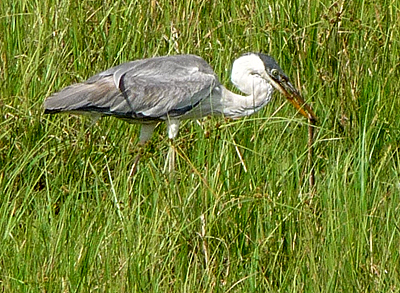 We left the lodge after lunch, heading north up the Transpantaneira. Many of the same water birds seen as we traveled and we stopped now and then for looks and photographs. At one point there were numerous Southern Caracaras hunting around a recently burned area. Further on we watched a Cocoi Heron trying to kill and eat a small Anaconda and a Capybara family with three young. We stopped at an area with some shade trees and small abandoned buildings and found a pair of Common Tody-flycatchers around their nest. Bare-faced Ibis and Black-backed Water Tyrant were seen in a nearby wet area and Ashy-headed Greenlet and Grayish Saltator were flitting in the roadside shrubs. Toward the back of the grove of trees Miguel found a Great Horned Owl chick perched on a low branch and an adult above it.
We left the lodge after lunch, heading north up the Transpantaneira. Many of the same water birds seen as we traveled and we stopped now and then for looks and photographs. At one point there were numerous Southern Caracaras hunting around a recently burned area. Further on we watched a Cocoi Heron trying to kill and eat a small Anaconda and a Capybara family with three young. We stopped at an area with some shade trees and small abandoned buildings and found a pair of Common Tody-flycatchers around their nest. Bare-faced Ibis and Black-backed Water Tyrant were seen in a nearby wet area and Ashy-headed Greenlet and Grayish Saltator were flitting in the roadside shrubs. Toward the back of the grove of trees Miguel found a Great Horned Owl chick perched on a low branch and an adult above it.
Continuing north, we took a side road into a private ranch that we had exclusive access to and on the way in a Blue-headed Trogon was seen and a Spotted Sandpiper pointed out in a roadside pond. We got out to walk in an open area where several Hyacinth Macaws were seen and Miguel told us about their feeding trees. We walked a short, quiet trail and on the way back four Scaly-headed Parrots flew over. Further along the track we stopped at an open grassland area and found Yellowish Pipit and Grassland Sparrow. After much patience and discussion about exactly how yellowish the pipit was or was not! we saw both birds extremely well. Next up was a Yellow-chinned Spinetail that eventually showed well in a marshy area close to the road.
We headed back to the main road and turned north again. As the sun set, a Crab-eating Fox was spotted ahead on the track. We approached slowly in the bus and amazingly the animal walked toward us allowing great views. Further on there were two more Crab-eating Foxes. It was dark now, and the sky was spectacularly clear and filled with stars. We turned off the main road toward our lodge and found Red Brocket Deer with the spotlight and a Pauraque.
Day 5 - Sunday, October 18
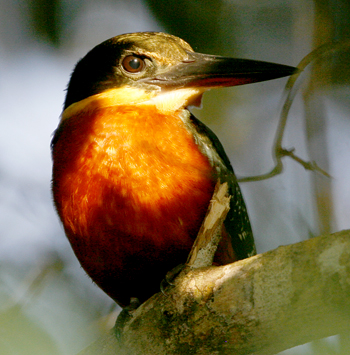 Just after sunrise we were up and out on the boats heading up the Pixiam River. Those of us out earlier saw a Black Skimmer flying up the river and as we set off there were the usual egrets, herons, and kingfishers. Our first stop was for a Great Black Hawk that had learned to retrieve fish that the boat driver threw out into the water. Further up the river on a muddy island, we had Pale-legged Hornero and nearby some Blue-fronted Parrots were perched in the riverside trees. Miguel spotted a Green-and-Rufous Kingfisher that flew in and perched under some bushes overhanging the bank. The boat man got us up close for great views as the sun lit up its rufous breast. In the same area, a Helmeted Manakin was heard but did not show and just ahead there were male and female Black-and-Gold Howler Monkeys in the trees. A Solitary Sandpiper was seen on the shore but it soon lost our attention to a pair of Sunbitterns on the beach that took off on a display flight and landed near each other a bit further up. They were calling to one another and continuing display behavior and we had front row views. A third Sunbittern flew further up the shore and landed on the water’s edge. It also called for several minutes and did not seem at all bothered by our presence allowing the best ever views, photos and even this video on YouTube>>
Just after sunrise we were up and out on the boats heading up the Pixiam River. Those of us out earlier saw a Black Skimmer flying up the river and as we set off there were the usual egrets, herons, and kingfishers. Our first stop was for a Great Black Hawk that had learned to retrieve fish that the boat driver threw out into the water. Further up the river on a muddy island, we had Pale-legged Hornero and nearby some Blue-fronted Parrots were perched in the riverside trees. Miguel spotted a Green-and-Rufous Kingfisher that flew in and perched under some bushes overhanging the bank. The boat man got us up close for great views as the sun lit up its rufous breast. In the same area, a Helmeted Manakin was heard but did not show and just ahead there were male and female Black-and-Gold Howler Monkeys in the trees. A Solitary Sandpiper was seen on the shore but it soon lost our attention to a pair of Sunbitterns on the beach that took off on a display flight and landed near each other a bit further up. They were calling to one another and continuing display behavior and we had front row views. A third Sunbittern flew further up the shore and landed on the water’s edge. It also called for several minutes and did not seem at all bothered by our presence allowing the best ever views, photos and even this video on YouTube>>
The next spectacle was a pair of Giant Otters that came in close to the boats swimming around and eating fish offered by the boat drivers. They were a bit cautious, coming out to retrieve the fish and then going back to the cover of the riverside bushes to eat it. Just up the river, a Jabiru was eating a fish on the beach and we watched in awe as it crushed the fish with its powerful beak until it was small enough to swallow whole.
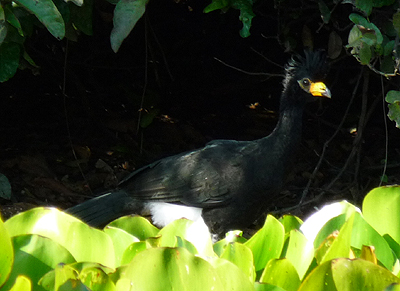 Around the next corner, we started to see several groups of fishermen along the river, some standing in the water (Caimans?). In a quieter area, a Sungrebe was seen swimming in the open and showing very well. We reached an area that was closed in by Water Hyacinth and searched the shoreline for birds. A Bare-faced Curassow was seen walking the river edge and two Golden-collared Macaws got our attention but remained hidden in the leaves above us. With a little effort and maneuvering, we all managed good views. Heading back down river, Miguel’s boat stopped for a small Anaconda that quickly disappeared on the bank. A perched Osprey was more confiding as it surveyed the river below. A Neotropic Cormorant suddenly surfaced with a large striped catfish in its bill. The fish was obviously too large to swallow and as the bird manipulated it, another Cormorant flew in and tried and steal it. On the next bank, a Pied Lapwing showed well and as we traveled we picked up a few more Sunbitterns for a total of 7 for the day. As we reached the dock, a Large-billed Tern was seen flying down river. We thanked our drivers for another magical morning on the river and headed in for breakfast. After breakfast, we met in the car park and loaded the bus. Some Red-crested Cardinals were seen near the feeders as well as several Scaled Doves and Saffron Finches.
Around the next corner, we started to see several groups of fishermen along the river, some standing in the water (Caimans?). In a quieter area, a Sungrebe was seen swimming in the open and showing very well. We reached an area that was closed in by Water Hyacinth and searched the shoreline for birds. A Bare-faced Curassow was seen walking the river edge and two Golden-collared Macaws got our attention but remained hidden in the leaves above us. With a little effort and maneuvering, we all managed good views. Heading back down river, Miguel’s boat stopped for a small Anaconda that quickly disappeared on the bank. A perched Osprey was more confiding as it surveyed the river below. A Neotropic Cormorant suddenly surfaced with a large striped catfish in its bill. The fish was obviously too large to swallow and as the bird manipulated it, another Cormorant flew in and tried and steal it. On the next bank, a Pied Lapwing showed well and as we traveled we picked up a few more Sunbitterns for a total of 7 for the day. As we reached the dock, a Large-billed Tern was seen flying down river. We thanked our drivers for another magical morning on the river and headed in for breakfast. After breakfast, we met in the car park and loaded the bus. Some Red-crested Cardinals were seen near the feeders as well as several Scaled Doves and Saffron Finches.
We continued north through the Pantanal toward Poconé stopping along the way for a pair of Whistling Herons close to the road in a pond. An Aplomado Falcon was seen perched on a termite mound feeding on something. Bare-faced Ibis were seen, as well as a close Savannah Hawk, another Sunbittern, Scaled Doves, Ruddy Ground-Doves, and some Long-tailed Ground-Doves around a farm fence.
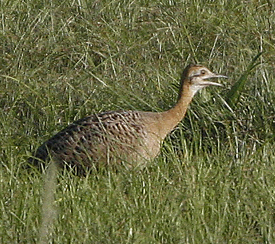 We left the Transpantaneira and stopped for lunch at the Churasscaria again and then continued past Cuiaba to our lodge in Serra das Araras. On our way into the lodge, we stopped to look at three Burrowing Owls on the ground in a grassy area. There was a Red -winged Tinamou walking out it the open and we were pleased with excellent views of this hard to see species. There were also several Plumbeous Kites around as we called into our pousada for the next two nights. In the garden there were the usual noisy Yellow -chevroned Parakeets in a tree with a pair of smart looking Yellow-tufted Woodpeckers. We dropped our bags in the rooms quickly and then set off in an open truck to a site in the valley where there was an active Harpy Eagle nest. There were two farm ponds along the way that held Least Grebe, Brazilian Teal, and Muscovy Duck.
We left the Transpantaneira and stopped for lunch at the Churasscaria again and then continued past Cuiaba to our lodge in Serra das Araras. On our way into the lodge, we stopped to look at three Burrowing Owls on the ground in a grassy area. There was a Red -winged Tinamou walking out it the open and we were pleased with excellent views of this hard to see species. There were also several Plumbeous Kites around as we called into our pousada for the next two nights. In the garden there were the usual noisy Yellow -chevroned Parakeets in a tree with a pair of smart looking Yellow-tufted Woodpeckers. We dropped our bags in the rooms quickly and then set off in an open truck to a site in the valley where there was an active Harpy Eagle nest. There were two farm ponds along the way that held Least Grebe, Brazilian Teal, and Muscovy Duck.
We arrived near the Harpy site and immediately got on to a Tiny Hawk, noting that in looking for one of the largest raptors, we had found one of the smallest. The Harpy Eagle nest was obvious in a large tree but there were no birds in it. The eight month old chick had left the nest a few weeks earlier and was now being tended to by the parents somewhere in the forest. We searched the trees with no luck but in the meantime found Scaled Pigeon, Toco Toucan, more Yellow-tufted Woodpeckers, Chestnut-eared Aracari, and a Straight-billed Woodcreeper. Brian spotted a Ferruginous Pygmy Owl perched high on a tree, where it started calling and also here were several Plumbeous Kites seen flying above. It was getting dark and we had to give up the Harpy search for the day. Back and the lodge, we enjoyed a nice meal, caught up with our checklist, and strategized at how we could find our target tomorrow.
Day 6 - Monday, October 19
Overnight rain had cooled things a bit and the first sounds of the day were from the Chopi Blackbirds around the pousada at some time after 4am. There annoying early singing habits earned them a new name, “The Devil’s Canary”. After breakfast we gathered in front of the lodge were we spotted an American Kestrel on a post not far away. The Yellow-tufted Woodpeckers were showing well and some Guira Cuckoos were around. A small flock of Dusky-headed Parakeets flew into the trees in front of the dining room and we had great scope views of them.
Once again we boarded the open truck and set off in search of the Harpy Eagle. There were several Ruddy Ground Doves seen along the way and the Brazilian Teal, Least Grebe, and Muscovy Duck were at the small pond. A Variegated Flycatcher was seen and a Swallow-wing flew off quickly. As we arrived at the drop off spot, there was a Tiny Hawk chasing a Plumbeous Hawk. No Harpys in sight, we scoped a Plumbeous Pigeon and Brian spotted a White-necked Puffbird. Miguel found some Brown at the top of a dead tree and took us down a trail to show them to us. Behind us a Black-tailed/Bare-eared Marmoset was climbing down a tree. A Cream-colored Woodpecker was seen and a distant Blue-headed Parrot was scoped with better, closer views obtained later. Some Lettered Aracaris showed well and there were many butterflies around including several Blue Morphos. Black-fronted Nunbirds were seen and at one point there were half a dozen more Marmosets in the trees. A Moustached Wren eluded some of us and all the while we were keeping watch for the Harpy Eagle but no luck. We got back on the truck and slowly made our way back with stops for two adult King Vultures flying over the ridge, Greater Yellow-headed Vulture, Roadside Hawk, some Swallow-tailed Kites, and a Hook-billed Kite. More Burrowing Owls were seen and there were Chalk-browed Mockingbirds around. We decided to check the other side of the valley for the Harpy so we cut across past a mostly dried up farm pond that had Wood Storks, Great Egrets, Snowy Egrets, Black Vultures, Solitary Sandpiper, and Brazilian Teal.
We drove a dirt track through the forest and checked all of the trees near and far. A Tayra crossed the road and quickly disappeared and a Black-tailed Trogon was seen. A large Tegu Lizard ambled down the track but more impressive was a Greater Rhea that ran down the track in front of us with three small chicks. In an open area American Kestrels were seen and a Lineated Woodpecker showed briefly on a distant tree trunk. As we turned around, a Hummingbird whizzed into an orange flowering tree and sped off before we could make a definite identification. On the way back, we stopped in a spot where a Pheasant Cuckoo was calling but the bird did not show. Below us, just off the road, was a superb looking Rainbow Boa that slithered away into the leaf litter.
In the afternoon, we drove out to the same track, this time to walk a trail in the forest. On the way, we had Masked Tityra and a nice Black-throated Saltator in a low tree as we waited for Miguel to tend to the gate. We then walked slowly in the shade of the trail and stopped for some female Band-tailed Manakins and a female Fork-tailed Woodnymph. A White-backed Fire-eye was seen as were Plain Antvireo and Blue-crowned Motmot. A Planalto Slaty-Antshrike was calling deep in the forest but it was too far to see. An Azara’s Agouti crossed the track ahead of us just before we got to an opening in the canopy where there was a flurry of activity beginning with White-shouldered Tanager, Masked Tityra, Forest Elaenia, Gray-headed Tanager, Rufous-browed Peppershrike, and Dull-capped Attila. Birding was fast and furious and we got varying views of these birds as well as Orange-winged Parrot. We came out of the forest and walked the dirt track to continue our search for the Harpy Eagle. Red-shouldered Macaws were seen and there was Blue-black Grassquit, Palm Tanager, a female Black-throated Trogon, and some Dusky-headed Parakeets in a Cecropia. A Gray-headed Kite flew in and perched on a bare tree but still no Harpy. On the way back there was an Azara’s Agouti on the trail and a Tayra crossed quickly. After dark, Miguel spotlighted a Common Potoo as it flew above us presumably hunting for insects.
Day 7 - Tuesday, October 20
This morning we were up before dawn and even before the Chopi Blackbirds to check an area for Red-bellied Macaw. We arrived at the site and sat in the bus for several moments as daylight brightened the very grey sky. A pair of Orange-winged Parrots flew over but it was difficult to get any colour on the birds in the bad light. A few Red-bellied Macaws flew above us again allowing mostly silhouette views. It started to rain which chased us back to the bus and then the lodge for breakfast and by the time we arrived is was raining steadily.
After breakfast we decided to brave the rain and go birding out on the forest trail. Before we left the lodge, we went to check on a White Woodpecker that Maurice had reported behind the rooms and there it was on a bare trunk. At the drying up pond, there were the usual birds plus a Jabiru. The forest trail was quiet but there were several frogs and toads that caught our attention and another Moustached Wren skulked through some bushes remaining elusive for some of us. The rain let up a bit and we could now hear the unrelenting call of several Undulated Tinamous. One sounded close by so some of us scanned the forest floor and found the bird calling not far from the trail. The rain had stopped now and bird activity was starting to pick up. Along the path we saw Black-fronted Nunbird, Yellow-rumped Cacique, a nice Buff-throated Woodcreeper, and five Chestnut-eared Aracaris in a tree high in the canopy. Miguel put us on a Spix’s Guan in a bare tree and we all got good views of it. We then walked a narrow trail through a thick forest that led out to the Harpy Eagle nest tree. Some Scaled Pigeons showed well in the tops of trees and a Masked Tityra was seen. We stood near the Harpy Eagle nest tree while Miguel went off in search of the bird. From our viewpoint, we had several Plumbeous Kites, Yellow-tufted Woodpecker, Pearl Kite, and Blue-headed Parrot. Miguel soon returned with a smile on his face - he had found 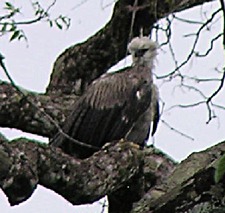 the juvenile Harpy Eagle! We all climbed the fence and followed him to an open area with a view of the bird in a large tree not far away. It was a welcome and amazing sight, the eight month old bird with its small head, large wings, and large feet. It looked a bit bedraggled from the rain but we didn’t mind. We had all but written off the chance to see the bird and now we had it in plain sight. We watched the bird for ½ hour or so as it peered alertly into the forest. At one point, it coughed up a pellet and we wondered what its most recent meal had been. It was a triumph for us and thanks to Miguel; we enjoyed great views of this fantastic looking bird. As we were getting ready to head back, a Lettered Aracari and a Chestnut-eared Aracari appeared in a nearby tree allowing good comparison views.
the juvenile Harpy Eagle! We all climbed the fence and followed him to an open area with a view of the bird in a large tree not far away. It was a welcome and amazing sight, the eight month old bird with its small head, large wings, and large feet. It looked a bit bedraggled from the rain but we didn’t mind. We had all but written off the chance to see the bird and now we had it in plain sight. We watched the bird for ½ hour or so as it peered alertly into the forest. At one point, it coughed up a pellet and we wondered what its most recent meal had been. It was a triumph for us and thanks to Miguel; we enjoyed great views of this fantastic looking bird. As we were getting ready to head back, a Lettered Aracari and a Chestnut-eared Aracari appeared in a nearby tree allowing good comparison views.
Elated at seeing the Harpy Eagle, we walked back through the forest to the bus and headed back toward the lodge. There were three King Vultures soaring over the ridge and a Gray Hawk perched on a far tree. After lunch, we left Serra das Araras heading toward Chapada dos Guimarães northeast of Cuiaba. Not far from Cuiaba the red cliffs came into view and we could see the flat topped mountains made of sandstone ahead of us. We stopped at an overlook for photos and happened upon a good flock that included several Swallow Tanagers, Blue Dacnis, Pale-breasted Thrush, Red-legged Honeycreeper, White-lined and Hepatic Tanager, White-bellied Warbler , Fork-tailed Woodnymph, and nice views of the endemic Planalto Slaty Antshrike. A pair of Blue-winged Macaws flew over and there were Gray-breasted Martins and brief views of a Swallow Flycatcher, a likely split from Cliff Flycatcher.
We continued on to Chapada dos Guimarães National Park arriving just before dusk where we walked along the entrance road. The road cut through some nice cerrado habitat where we picked up Guira Tanager, Purple-throated Euphonia, and Masked Tityra. There were a couple of Small-billed Tinamous running around on the road allowing good views and a Grassland Sparrow was seen perched on a tall blade of grass. We arrived at our charming private lodge located on a 370 acre reserve overlooking the park and checked into our rooms. We all met up again for the checklist and dinner in the lodge’s lovely dining room.
Day 8 - Wednesday, October 21
We spent this morning exploring the area in and around Chapada dos Guimarães National Park . While birding the expanses of low vegetation, we found Red-crested Finch, Plumbeous Seedeater, Shrike-like/White-banded Tanager, Double-collared Seedeater, White-crested Elaenia, and Burnished Buff Tanager. A perched Swallow-tailed Hummingbird gave nice views and nearby we had Lesser Elaenia, Rufous-browed Peppershrike, Glittering-bellied Emerald , White-vented Violetear, Pale-vented Pigeon and Plain-crested Elaenia. Some Red-and-Green Macaws were flying around and we had our first Curl-crested Jay in the scope. A Yellow-bellied Elaenia was seen as well as White-rumped Tanager, Pale-breasted Spinetail and a Grassland Sparrow perched nicely on a post. We walked a red sand road where there were several Burrowing Owls on posts and even on the sandy track in front of us. An Aplomado Falcon was scoped as it perched on a low tree and a Savannah Hawk showed well. Black-throated Saltator was seen just before several Curl-crested Jays came closer and began hawking insects from tree top perches. Miguel found us the endemic Chapada Flycatcher and we had prolonged views of this bird allowing us to study the plumage of this juvenile bird with spotting on the mantle. As it sat perched a Plain-crested Elaenia came in and had a battle with it. In the distance a mixed flock of Mississippi and Plumbeous Kites flew by and several groups of White-eyed Parakeets flew over.
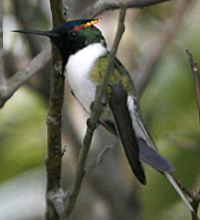 We reached a gate for the National Park where there was a White-eyed Puffbird on a cement post. There were a few Chalk-browed Mockingbirds around and as we scanned the vegetation a gorgeous male Horned Sungem came in and perched briefly, its crown glowing as it turned into the light. The bird flew off after a few seconds and we waited quietly for it to return. Suddenly, Miguel whispered “Maned Wolf” and we all maneuvered to see this magnificent animal that David had spotted as it approached the gate where we were standing. The wolf turned and loped down the path and we watched it retreat noting its long black legs and reddish coat. It was a mammal that we knew was in the area but never expected to see. For David, it was the bird of the trip! And we must say an excellent find. On the way out of the area, we stopped to look at group of Curl-crested Jays harassing a Southern Caracara. Then we continued to another area next to a large hotel overlooking a sprawling valley. As we drove in a Pale-breasted Thrush was seen and from the car park we could see Plumbeous Kites flying below. We birded an area past the restaurant that produced a White-bellied Warbler and a stunning male
We reached a gate for the National Park where there was a White-eyed Puffbird on a cement post. There were a few Chalk-browed Mockingbirds around and as we scanned the vegetation a gorgeous male Horned Sungem came in and perched briefly, its crown glowing as it turned into the light. The bird flew off after a few seconds and we waited quietly for it to return. Suddenly, Miguel whispered “Maned Wolf” and we all maneuvered to see this magnificent animal that David had spotted as it approached the gate where we were standing. The wolf turned and loped down the path and we watched it retreat noting its long black legs and reddish coat. It was a mammal that we knew was in the area but never expected to see. For David, it was the bird of the trip! And we must say an excellent find. On the way out of the area, we stopped to look at group of Curl-crested Jays harassing a Southern Caracara. Then we continued to another area next to a large hotel overlooking a sprawling valley. As we drove in a Pale-breasted Thrush was seen and from the car park we could see Plumbeous Kites flying below. We birded an area past the restaurant that produced a White-bellied Warbler and a stunning male 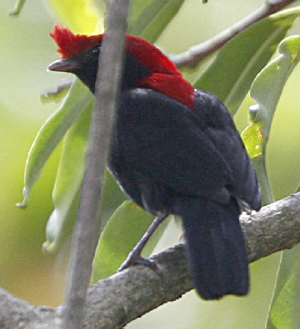 Helmeted Manakin that perched for several minutes and then flew in close to us showing its bright crimson crest. In the lower vegetation, we had Large-billed Antwren, a Planalto Hermit that made a quick visit to some flowers, and a smart looking Sooty-fronted Spinetail. A Buff-throated Saltator was seen in the trees and a Masked Yellowthroat showed well in a tree next to us.
Helmeted Manakin that perched for several minutes and then flew in close to us showing its bright crimson crest. In the lower vegetation, we had Large-billed Antwren, a Planalto Hermit that made a quick visit to some flowers, and a smart looking Sooty-fronted Spinetail. A Buff-throated Saltator was seen in the trees and a Masked Yellowthroat showed well in a tree next to us.
We walked down a trail into the forest and tried to get on a skulky Saffron-billed Sparrow. All of us finally caught up with the Moustached Wren a little further down the trail and there was a pair of White-bellied Warblers bringing food presumably to a nearby nest. We enjoyed an excellent lunch at the open air restaurant overlooking the valley and from the lunch table Doreen spotted the Helmeted Manakin perched on a branch in the area where we had seen it earlier. There was also a Green-winged Saltator in the same area.
After lunch we drove back to the park and walked to the viewing area overlooking the Bridal Veil waterfall that plunges 86 meters from the top of a plateau. There were several Great Dusky Swifts clinging to the cliff face next to and behind the waterfall and a Swallow Flycatcher was also spotted on a dryer area of the cliff face. White-eyed Parakeets were all around as we watched a rain storm 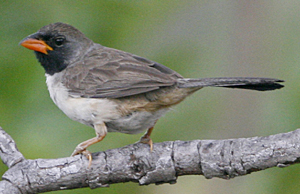 approach that eventually chased us up the hill seeking cover in an open air café. Birding continued from the café with female Barred Antshrike, White-lined Tanager, White-eared Puffbird, Thick-billed Euphonia, Streaked Flycatcher and Rufous Hornero all seen in the nearby vegetation. When the rain ended we walked back down to the waterfall overlook and had good views of Biscutate Swifts flying below us in the valley, their broken collar visible as they dropped below the horizon. A colorful Lizard was resting on a low tree branch and we got our last looks at the lovely waterfall. Walking back to the bus, we added Narrow-billed Woodcreeper and Black-throated Saltator as well as another closer Swallow Tanager.
approach that eventually chased us up the hill seeking cover in an open air café. Birding continued from the café with female Barred Antshrike, White-lined Tanager, White-eared Puffbird, Thick-billed Euphonia, Streaked Flycatcher and Rufous Hornero all seen in the nearby vegetation. When the rain ended we walked back down to the waterfall overlook and had good views of Biscutate Swifts flying below us in the valley, their broken collar visible as they dropped below the horizon. A colorful Lizard was resting on a low tree branch and we got our last looks at the lovely waterfall. Walking back to the bus, we added Narrow-billed Woodcreeper and Black-throated Saltator as well as another closer Swallow Tanager.
We drove back toward the lodge and once inside the gate we spotted two Rusty-margined Guans on the road. A Yellow-ridged Toucan was also seen from the bus but it got away before all of us got on it. We still had some daylight left when we arrived back at the lodge so we decided to enjoy a few beers as we watched the beautiful scenery from the veranda. We were happy just with the view but soon three Dark-billed Cuckoos appeared in a small Cecropia not far away. An Epaulet Oriole also appeared in the same tree and as Elaenias were flying in and out, we decided this was to be called the “Tree of Life”.Behind it in a larger tree, two Yellow-ridged Toucans appeared allowing those that had missed them from the bus to catch up, and then Lesley spotted the Planalto Hermit right in front of us where we had prolonged views of the bird feeding on some orange flowers. A Little Woodpecker was seen in another tree and a female Glittering-bellied Emerald made a quick visit to the flowers. Steve spotted a nighthawk flying across the valley which turned out to be a Nacunda Nighthawk, another new bird for the trip. The sun was setting in front of us as we enjoyed the idyllic setting and the bonus birds seen during our afternoons happy hour. Later on, as we walked to dinner some of us heard a Tropical Screech-owl calling from the valley.
Day 9 - Thursday, 22nd October
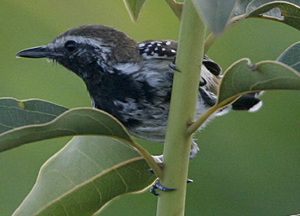 We had a very early breakfast today to make the most of our last few hours of birding. As the daylight came up we had Pale-bellied Thrush at the lodge and then better views at Rusty-margined Guans in the road as we drove out. We checked another area of Chapada habitat on a forest edge and could hear both Small-billed and Red-winged Tinamou but neither showed. It was relatively quiet but we did pick up Black-faced Tanager, a Plumbeous Kite perched on a tree near some Yellow-tufted Woodpeckers and a couple of White-vented Violetears on a dead stick. A stunning Swallow-tailed Kite flew over and a White-eared Puffbird was seen perched up on a bush. A pair of Blue-winged Macaws was chattering on the roof of a nearby house (and we thought Chopi Blackbirds were noisy!).
We had a very early breakfast today to make the most of our last few hours of birding. As the daylight came up we had Pale-bellied Thrush at the lodge and then better views at Rusty-margined Guans in the road as we drove out. We checked another area of Chapada habitat on a forest edge and could hear both Small-billed and Red-winged Tinamou but neither showed. It was relatively quiet but we did pick up Black-faced Tanager, a Plumbeous Kite perched on a tree near some Yellow-tufted Woodpeckers and a couple of White-vented Violetears on a dead stick. A stunning Swallow-tailed Kite flew over and a White-eared Puffbird was seen perched up on a bush. A pair of Blue-winged Macaws was chattering on the roof of a nearby house (and we thought Chopi Blackbirds were noisy!).
We moved on to another area and walked a road where we had Black-throated Saltator, nice looks at Rusty-backed Antwren and White-rumped Tanager. A Chalk-browed Mockingbird covered with red dust from the road was seen and confused us for a while. And further on, Miguel found a Rufous-winged Antshrike and we had Plain-crested Elaenia, Cinnamon Tanager, and Guira Cuckoo in the area. More Swallow-tailed Kites flew over, a couple of them very close looking quite stunning as they came by.
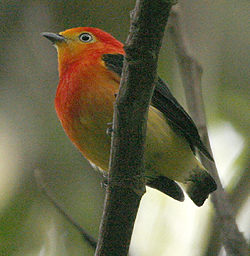 Our last stop of the morning was in an area of privately owned forest. As we entered the forest, several Brown Capuchins were seen and a Plain Antvireo was watched worked the understory. We arrived at a Band-tailed Manakin lek and soon found two bright males posing for us in the trees. We watched the birds for several minutes and the highlight was when one of the males danced along a branch right above us. Fabulous!
Our last stop of the morning was in an area of privately owned forest. As we entered the forest, several Brown Capuchins were seen and a Plain Antvireo was watched worked the understory. We arrived at a Band-tailed Manakin lek and soon found two bright males posing for us in the trees. We watched the birds for several minutes and the highlight was when one of the males danced along a branch right above us. Fabulous!
We walked through the forest, over a small stream and up a slippery hill to an open area where there was a nest of Ornate Hawk-Eagle in a tree. The nest had recently been built, but unfortunately there were no birds in attendance. Nearby there was a large colony of Yellow-rumped Caciques and a Crested Oropendola with Giant Cowbirds parasitizing them. David spotted a Black-crowned Tityra that flew into a tall tree up the hill and Doreen spotted a Blue-crowned Trogon perched low at the forest edge. While watching the trogon, we noticed a Ferruginous Pygmy-Owl on a low branch nearby and as we got on to that a Bat Falcon flew fast overhead. We headed back through the forest and when we came out our hostess offered us a much appreciated glass of fresh cashew juice. On the way to the bus, the owner of the property pointed out a pair of Thick-billed Euphonias building a nest in a palm tree in the grounds of the house.
On the road back to the lodge, we had nice looks at a Swallow-wing on top of a tree. We took a few minutes to pack and say goodbye to our gracious host before heading to the airport for our flight home. On the way to the airport, a White-tailed Hawk was seen.
At the airport, we said goodbye to our excellent driver Manuel. While Miguel traveled with us to Sao Paulo and then caught a different flight back to his home in Iguazu Falls.
This was a superb trip, and we would like to thank Miguel for his expert guiding, patience and perseverance to find our target birds, especially the Harpy Eagle. Excellent!
We would also like to thank Derek L. for the use of his photo of the Harpy Eagle. All other photos taken by Steve and Gina during the tour.

